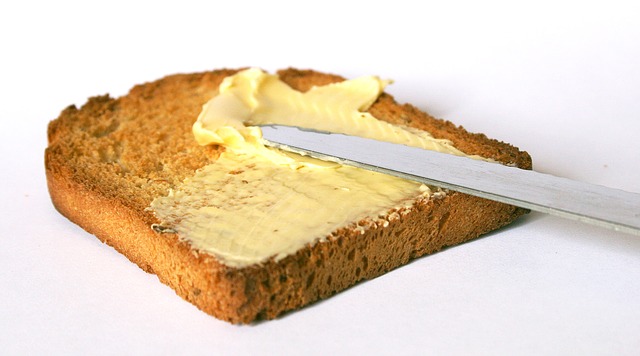What is real butter? There is often confusion involving real and imitation butter because there is just an enormous variety of products available. If your grocery dairy aisle is anything like mine, there is a large section devoted to just butter or butter-like products. It can be hard to determine what is real butter and what is the fake stuff.
Real butter is cream or milk that has been churned until the butterfat has separated from the buttermilk. The buttermilk is drained leaving only the butterfat. The butterfat is what we know as butter. It consists of approximately 80 percent milk fat, 17 percent water, and a small percentage of milk solids. There also may be sodium added to salted varieties of butter.
Real Butter
There are several different types of real butter. When you read the ingredients label of a real butter the ingredients should simply be cultured cream and/or milk and possibly salt. This is the butter you should use if a recipe calls for real butter or butter in general. It is generally sold in sticks and is commonly labeled plainly as butter (unsalted or salted). You may also see European style butter in your store. This is also real butter that can be used the same way as regular butter but it has a higher fat percent. Additionally, whipped butter is commonly also real butter, however, it has more air than regular butter. It should not be used in baking because the measurements between real butter and whipped butter will not be the same.
Sort of Real Butter
Outside of the above real butter products, there are what we like to call the sort of real butter products. These products contain the traditional ingredients of butter (cream, salt) but they also have a slew of other ingredients. For example, light butter has the main ingredients of cream and salt but also contains ingredients like water, buttermilk, food starch, tapioca maltodextrin, distilled monoglycerides, lactic acid, xanthan gum, potassium sorbate and more. While light butter often contains about 50 percent fewer calories, you have to ask yourself if it is really butter given the additional ingredients. Note that light butter is not recommended to be used for baking because the extra water tends to alter the intended texture.
In addition to light butter, there are also the spreadable kinds of butter. These are typically butter with oil (canola, olive) added to create a spreadable product straight out of the refrigerator. Spreadable butter is meant to spread on bread or to flavor foods like vegetables, and it is not meant for baking.
Imitation Butter
Margarine and other spreads are butter substitutes and are not real butter. Margarine is typically made from refined vegetable oils (sunflower, canola, olive), water, some milk, and salt. Some imitation butter brands are Country Crock, Brummel & Brown, I Can’t Believe It’s Not Butter!, Imperial, Parkay, and Blue Bonnet.

